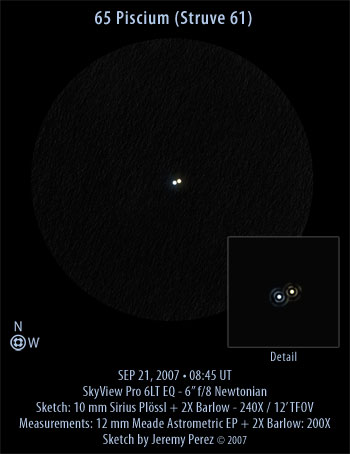
Click image for larger version
Observation Notes:
This double star pair is of equal brightness, and in my 15 cm reflector, appeared to be separated by the radii of about 3 diffraction rings, or about 3.7 arc seconds. I measured PA at 292 or 112 degrees (depending on which star was the primary) and estimated the color of the southeast as pale blue, with a pale yellow northwest companion. The Tycho Double Star Catalog gives 1991 values of 295.9 degrees PA and 4.36 arc seconds separation. Using diffraction ring positioning in bubbly seeing is turning out to be a pretty rough way to estimate separation on relatively close doubles.
| Subject | 65 Piscium (STF 61) |
| Classification | Double Star |
| Position (J2000) | Pisces [RA: 00:49:53.2 / Dec: +27:42:36]* |
| Position Angle* | 292° [2007.7 my measurement] 295.9 [1991 TDSC] 297° [1820 WDS] |
| Separation* | 3.7" [2007.7 my measurement] 4.36 [1991 TDSC] 4.4" [1825 WDS] |
| Magnitudes* | 6.3 / 6.3 |
| Spectral Types* | F0III / F2IV |
| Date/Time | SEP 21, 2007 - 1:45 AM MST (SEP 21, 2007 - 08:45 UT) |
| Observing Loc. | Flagstaff, AZ - Home |
| Instrument | Orion SVP 6LT Reflector (150 mm dia./1200 mm F/L) |
| Eyepieces/Mag. | 10 mm Sirius Plössl + 2X Barlow (240X) 12 mm Meade Astrometric EP + 2X Barlow (200X) |
| Conditions | Clear, breezy |
| Seeing | 5/10 Pickering |
| Transparency | NELM Mag ~5.8 |
| *References | The Washington Visual Double Star Catalog, 1996.0 (Worley+, 1996); Catalogue of Stellar Spectral Classifications (Skiff, 2005); Stellar Spectra Classified in Morgan-Keenan System (Jaschek+ 1964); Starry Night Pro Plus 5.8 |




